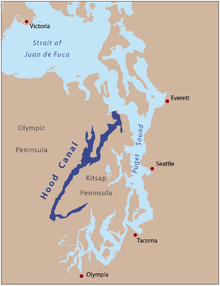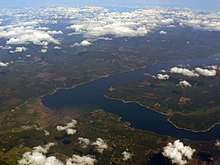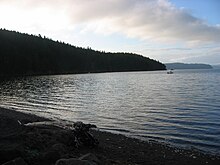Hood Canal

Hood Canal is a fjord forming the western lobe, and one of the four main basins,[1][2][3] of Puget Sound in the State of Washington. Hood Canal is not a canal in the sense of being a man-made waterway—it is a natural waterway.
Geography

Hood Canal is long and narrow with an average width of 1.5 miles (2.4 km) and a mean depth of 53.8 metres (177 ft). It has 342.6 kilometres (212.9 mi) of shoreline and 42.4 square kilometres (16.4 sq mi) of tideland. Its surface area is 385.6 square kilometres (148.9 sq mi) and it contains a volume of water totaling 21 billion cubic meters (17 million acre-ft).[3] Hood Canal extends for about 50 miles (80 km) southwest from the entrance between Foulweather Bluff and Tala Point to Union, where it turns sharply to the northeast, a stretch called The Great Bend. It continues for about 15 miles (24 km) to Belfair, where it ends in a shallow tideland called Lynch Cove.
Along its entire length, Hood Canal separates the Kitsap Peninsula from the Olympic Peninsula of Washington. The U.S. Navy's Naval Base Kitsap, Bangor Annex, is located on the eastern shore of Hood Canal near the town of Bangor. Hood Canal has several internal bays, the largest of which is Dabob Bay. Most of Dabob Bay is a Naval Restricted Area, and is used by the submarines stationed at the Bangor Base. Quilcene Bay is an inlet extending northwest from Dabob Bay. Near the north end of Hood Canal is Port Gamble, a bay and a town of the same name.
Several rivers flow into Hood Canal, mostly from the Olympic Peninsula, including the Skokomish River, Hamma Hamma River, Duckabush River, Dosewallips River, and Big Quilcene River. Small rivers emptying into Hood Canal from the Kitsap Peninsula include the Union River, Tahuya River, and Dewatto River.
Geology
Hood Canal and the rest of Puget Sound were created about 13,000 years ago, during the Late Pleistocene, by the Puget Lobe of the Cordilleran Ice Sheet.[4]
History

Hood Canal was named by the Royal Navy Captain George Vancouver on May 13, 1792, in honor of Admiral Lord Samuel Hood of that navy. Vancouver used the name "Hood's Channel" in his journal, but wrote "Hood's Canal" on his charts. The United States Board on Geographic Names decided on "Hood Canal" as its official name in 1932.[5][6]
Roads and bridges
U.S. Route 101 runs along the west shore of Hood Canal, south of Quilcene.
Hood Canal is spanned by the Hood Canal Bridge, the third longest floating bridge in the world at 6,521 feet (1,988 m). According to the Washington State Department of transportation, the Hood Canal Bridge is the only floating bridge constructed on saltwater,[7] although there are others, such as Nordhordland Bridge and Bergsøysund Bridge. The Hood Canal Bridge accommodates sixteen and a half foot tides.
Recreation
There are several state parks [8] on the shores of Hood Canal including Belfair, Twanoh, Potlatch, Triton Cove, Scenic Beach, Dosewallips, Kitsap Memorial, and Shine Tidelands.
Theler Wetlands is located at the tip of the Canal in Belfair. It provides a few miles of trails and a protected environment for marsh and estuary birds and plants.[9]
Low oxygen levels
September 2006 marked the discovery of the largest dead zone in the history of Hood Canal. The dead zone may have been caused by low oxygen levels due to algal blooms.[10] Algal blooms occur in part because of warm weather and the slow turnover of water in the southern end of the canal, causing the build-up of nutrients from fertilizers and leaky septic systems. When the algae die, bacteria feed and their populations explode, robbing the water of oxygen. The fish kill may also be part of a natural 50-year cycle of oxygen levels in the canal[11][12], which has merely been influenced (but not controlled) by anthropogenic activity.
In May 2006, divers searching for invasive species discovered a mat of marine bacteria covering a 4-mile (6.4 km) stretch where all normal sea life was dead. The mat dissipated five months later.[13] Jan Newton, oceanographer at the University of Washington, said it was important to note that Hood Canal has had very low oxygen for a long time. Similar mats have been found near Tacoma, Washington; San Diego, California; New York City; and New Orleans, Louisiana.[13]
The oxygen level may also be partially due to a change in wind direction. The prevailing north wind generally pushes oxygenated water into the oxygen-depleted area. A sustained south wind will cut off this source of oxygen.[10][11]
The Hood Canal Dissolved Oxygen Program, a partnership of 28 organizations, has been formed to combat the problem.[14] This program will work with local, state, federal, and tribal government policy makers to evaluate potential corrective actions that will restore and maintain a level of dissolved oxygen that will reduce stress on marine life.[15]
Icing Over
During a week of record-breaking cold temperatures in December 2009, parts of Hood Canal developed a thin layer of ice, thicker near the shoreline. [16]
References
- ^ U.S. Geological Survey Geographic Names Information System: Puget Sound
- ^ Environmental History and Features of Puget Sound, see also: Map of subareas of Puget Sound, National Oceanic and Atmospheric Administration and National Marine Fisheries Service
- ^ a b Features Of Puget Sound Region: Oceanography And Physical Processes, Chapter 3 of the State of the Nearshore Report, King County Department of Natural Resources, Seattle, Washington, 2001.
- ^ Olympic Mountains, USGS Cascades Volcano Observatory
- ^ Phillips, James W. (1971). Washington State Place Names. University of Washington Press. ISBN 0-295-95158-3.
- ^ U.S. Geological Survey Geographic Names Information System: Hood Canal
- ^ Washington State Department of Transportation (2005). "Hood Canal Bridge Retrofit" (PDF). Retrieved 2006-11-29.
{{cite web}}: Unknown parameter|month=ignored (help) - ^ Washington State Parks. "Washington State Parks" (Web). Retrieved 2006-11-29.
- ^ Mary E. Theler Community Center & Wetlands
- ^ a b McClure, Robert (September 20, 2006), "Hood Canal fish suffocate", The Seattle Post-Intelligencer
{{citation}}: CS1 maint: date and year (link) - ^ a b Associated Press; "Study suggests natural oxygen cycle in Hood Canal"; (Seattle) KOMONews.com; April 25, 2007
- ^ "Relationship Between Pacific Decadal Oscillation and Paleo-Tracers of Hypoxia in Sediment Cores from Puget Sound, WA"
- ^ a b Dodge, John; "Bacterial mass in canal dissipates"; The Olympian; October 26, 2006
- ^ Hood Canal Dissolved Oxygen Program
- ^ HCDOP Goals, Hood Canal Dissolved Oxygen Program; May 24, 2004
- ^ [1], Watch: Ice on Hood Canal, KING 5 TV; December 10, 2009
